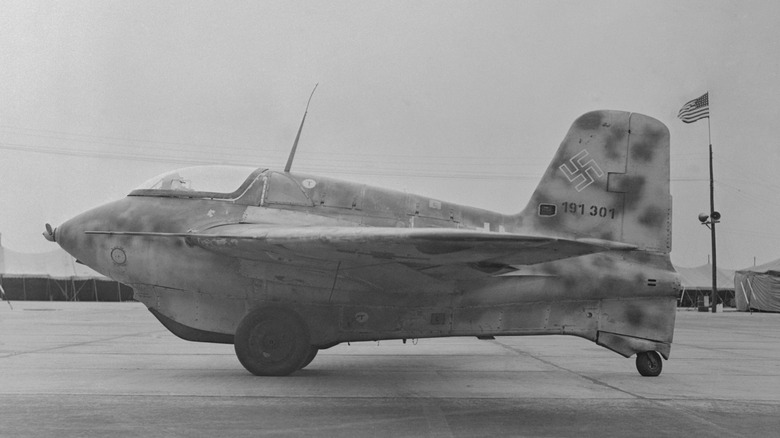Messerschmitt Me 163 Komet: The German WWII Warplane That Was Ahead Of Its Time
Over the course of World War II, the Nazis invented a lot of different weapons to get an upper hand. Some fundamentally changed combat forever, like the V2 rocket, the first operational ballistic missile, the Me 262, the first fighter jet, or even the Stg-44, the first assault rifle. But some of their machines did not make waves, at least as they were intended to, one such invention is the Messerschmitt Me 163 "Komet," a rocket powered interceptor plane.
Look at the Komet and you'll immediately notice how small it is at just over 19 feet long with a wingspan of 30 feet, 7 inches. For comparison, a P-51 Mustang (perhaps the greatest plane to ever fly) is over 32 feet long and has a wingspan of 37 feet. It was designed as part of Nazi Germany's "Wunderwaffen" or "Wonder Weapon" program, but fizzled out before it made any real impact on the war. According to the National Air and Space Museum, who is in possession of one of only five Komets that made its way to the United States, the Me 163 was the first and only plane of its kind to ever see service.
An evil technological marvel
It's important to note that the Me 163 was not a good aircraft by any means, nor was it particularly safe. But before you take account of its many downfalls, one must look at what the Komet managed to accomplish. First, it was extremely fast for the time, in fact it became the fastest manned craft when it reached a top speed of 623 miles per hour in 1942. In the days before breaking the sound barrier was commonplace among fighter planes, north of 600 miles per hour might as well have been light speed compared to other aircraft at the time.
It achieved these speeds due to another innovation it contained in its small airframe, a rocket motor. Rocket technology had existed for a while, but no one could harness it well enough to strap a person to a rocket and do something more than hope for the best. The Komet's Walter 509A-2 rocket was fueled by a combination of hydrogen peroxide, water, and methyl alcohol (also known as methanol, a common fuel used in racing). It produced between 3,300 and 3,700 pounds of thrust.
A poor choice for combat
With the technological advancements the Komet made, come with it all of its many downsides. Perhaps most importantly, it was made by the Third Reich, meaning that it would have been decidedly a travesty if it was effectively deployed in combat. The Nazi swastika on the tail tells you all that you need to know about what this plane was planned for. With only a tiny liquid fueled rocket motor as its only form of propulsion, the Me 163 had a total of around seven to eight minutes (yes, minutes) of flight time before it had to glide to a landing. It's estimated that it only had enough fuel to make one or two passes at American bomber planes before the rocket burned out. It was armed with two fairly stout 30-millimeter cannons, but the pilot would have to possess near robotic reflexes and timing to get the guns to score a hit before he rocketed past the target. As such, Komets attained a total of just nine air kills during the war.
With its small size and rocket engine, you wouldn't be too far off in saying that it looked like a Wile E. Coyote creation, as it was also extremely dangerous to fly. The fact that it didn't have proper landing gear was the least of the pilot's problem. The aforementioned fuel mixture had a tendency to randomly explode in flight. Overall, 14 Komets were lost in the war.
Dangerous to fly
According to the National Museum of the United States Air Force, the Komet didn't see combat until 1944 and was only operated by one unit in Nazi Germany's air force, the Luftwaffe. If the war had gone on any longer, it's doubtful that Nazi Germany would have been able to get enough Komets in the air long enough to make a real impact. The plane was not only ineffective and dangerous to fly, the forced labor used to construct the plane was likely actively sabotaging Komets as it was being produced. The Komet in possession of the National Museum of the U.S.A.F. bears French writing on the inside and a strategically placed rock that would have likely downed the aircraft if it was to be used in combat.
While the Komet made technological advancements in rocketry that would later come to play decades later, it was ultimately a poor excuse of an aircraft that would more likely kill its own pilot before anything else.



